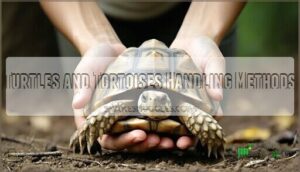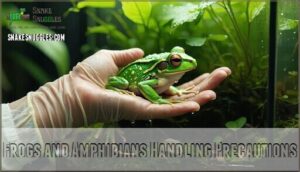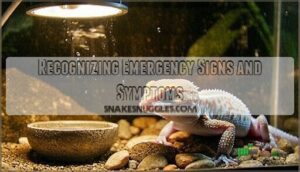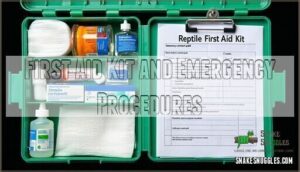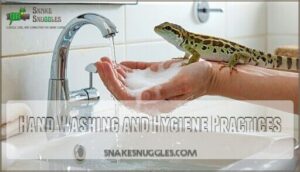This site is supported by our readers. We may earn a commission, at no cost to you, if you purchase through links.
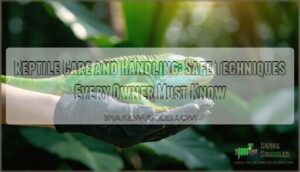 Proper reptile care and handling starts with understanding your specific species’ needs and temperament.
Proper reptile care and handling starts with understanding your specific species’ needs and temperament.
You’ll want to wash your hands before and after contact, move slowly to avoid startling your pet, and always support their entire body weight.
Watch for stress signals like hissing, rapid breathing, or color changes that tell you it’s time for a break.
Most reptiles prefer minimal handling, so keep sessions short and sweet.
Using the right tools—like snake hooks or padded gloves—can make the experience safer for both of you.
The secret lies in reading your reptile’s body language and knowing when less is definitely more to ensure a safe and enjoyable interaction for your pet, which is the key to proper reptile care.
Table Of Contents
- Key Takeaways
- Reptile Handling Basics
- Species-Specific Handling
- Health and Safety Considerations
- Environmental and Ethical Considerations
- Advanced Reptile Care and Handling
- Frequently Asked Questions (FAQs)
- How do you handle a skittish reptile?
- Do reptiles get stressed when handled?
- How do you handle a calm reptile?
- How do you handle a feisty reptile?
- What is the general response when handling a reptile?
- Do you need a reptile vet?
- Do you have to wash your hands after handling reptiles?
- Do any reptiles like being handled?
- Are reptiles high maintenance?
- How hard is it to take care of a reptile?
- Conclusion
Key Takeaways
- You’ll need to research your specific reptile species thoroughly – each has a unique temperament, habitat requirements, and handling needs that directly impact care success
- Always wash your hands before and after handling – this prevents Salmonella transmission and other zoonotic diseases that most reptiles naturally carry
- Watch for stress signals like hissing, color changes, or rapid breathing – these warning signs tell you when to stop handling and give your reptile a break
- Keep handling sessions short at 10-15 minutes maximum – most reptiles prefer minimal contact, so brief interactions reduce stress and build trust over time
Reptile Handling Basics
Getting started with reptile handling requires understanding your specific species’ needs and temperament before you ever pick up your scaly friend.
Whether you’re considering a docile leopard gecko or a more challenging snake, proper research and preparation will keep both you and your reptile safe and stress-free.
Researching Species-Specific Needs
Before bringing any reptile home, you’ll need to dig deep into species research.
Each reptile species has unique needs that determine their care success.
Understanding your reptile’s unique biology unlocks successful handling and long-term health.
Start your research with these essentials:
- Species Temperament – Some bite, others tolerate handling well
- Habitat Requirements – Temperature, humidity, and space needs vary dramatically
- Dietary Needs – From crickets to specialized pellets
- Veterinary Research – Find exotic vets before emergencies strike
Understanding species-specific needs prevents costly mistakes and guarantees your reptile thrives.
Assessing Experience Level
Before handling any reptile, you’ll need to honestly evaluate your experience level.
Use self-assessment tools to gauge your comfort with different animals and handling techniques.
Start with species complexity that matches your skills – first-time keepers shouldn’t jump into advanced reptile care without proper preparation.
Research learning resources and seek expert consultation to understand species recommendations and develop a safe handling progression plan.
Choosing Beginner-Friendly Species
Once you’ve evaluated your experience level, select species known for their docile nature and straightforward reptile care requirements.
Leopard geckos and corn snakes top the list for beginner-friendly species due to their calm temperament concerns and habitat simplicity.
These reptiles tolerate handling frequency well while offering affordability factors that won’t break the bank.
Both snakes and lizards in this category require minimal specialized equipment, making your first reptile handling experience successful and stress-free.
Understanding Habitat Requirements
Your reptile’s home setup directly impacts their health and handling success.
Temperature gradients should span 10-15°F between basking and cool zones, while humidity levels must match species needs—desert reptiles prefer 30-40%, tropical species need 60-80%.
Proper enclosure size, lighting needs, and substrate types create comfort zones that reduce stress during interactions.
Providing adequate heat is essential, so consider using appropriate basking lamps.
Safety Guidelines and Precautions
Beyond proper technique, establishing thorough safety protocols protects both you and your reptile companion.
These precautions prevent accidents, reduce stress, and guarantee positive handling experiences for everyone involved.
- Handling Precautions: Keep sessions brief (10-15 minutes), avoid handling during shedding or after feeding, and always support the reptile’s entire body to prevent injury.
- Emergency Protocols: Maintain a first aid kit with Betadine, sterile gauze, and antibiotic ointment while knowing your exotic veterinarian’s contact information for urgent situations.
- Zoonotic Prevention: Practice thorough hand washing before and after handling, keep reptiles away from food preparation areas, and never allow free roaming in living spaces.
- Child Supervision: Always supervise children during interactions, teach proper reptile safety protocols, and choose kid-friendly species with gentle temperaments for family pets.
Understanding a reptile’s species specific needs is vital for safe interactions.
Species-Specific Handling
Each reptile species requires unique handling methods based on their size, temperament, and natural behaviors.
You’ll need to master different techniques for snakes, lizards, turtles, and amphibians to keep both you and your pet safe during interactions, which involves understanding their natural behaviors.
Snakes and Lizards Handling Techniques
Snake hooks and tongs provide safe handling for defensive species, while lizard restraint requires supporting all limbs.
Never grab lizards by their tails—autotomy prevention means understanding tail-dropping defenses.
Python handling demands two-point body support, especially for arboreal species needing spine alignment.
Use protective gloves for aggressive monitors and water dragons.
These snake handling tools and techniques guarantee both handler and reptile safety. When handling snakes, it’s vital to grasp behind the head for initial control, ensuring proper technique.
Turtles and Tortoises Handling Methods
Unlike snakes and lizards, turtles and tortoises require different handling techniques due to their unique anatomy. Use a secure shell grip with both hands positioned between the forelimbs and hind limbs for safe handling.
Support their body weight completely to prevent falls that could crack their shells. Watch for their impressive bite force—even smaller species can deliver painful bites.
Provide proper neck support and maintain aquatic safety during transfers. Understand their terrestrial needs when handling land-dwelling tortoises.
Many turtles associate humans with food, and keepers should be aware of this general turtle behavior.
Frogs and Amphibians Handling Precautions
Amphibians require extra care since their permeable skin makes them vulnerable to contamination and stress.
Their delicate skin absorbs everything it touches, making gentle handling absolutely essential for amphibian safety.
You’ll need to handle these delicate creatures with specific precautions to guarantee their health and safety.
Essential handling precautions include:
- Gloves Required – Use powder-free, damp gloves to protect their sensitive skin from oils and contaminants
- Minimize Handling – Limit sessions to under 5 minutes to prevent stress and skin damage
- Disease Transmission – Wash hands thoroughly before and after contact to prevent deadly pathogens like chytrid fungus
Crocodilians Handling and Safety
Crocodilians require expert consultation before any handling attempts due to their lethal bite force and aggressive nature.
You’ll need specialized crocodilian restraint equipment, secure enclosure security measures, and professional training for bite prevention.
Species differences matter substantially—saltwater crocodiles pose greater risks than American alligators.
Unlike other reptiles, crocodilians demand institutional-level safety protocols and aren’t suitable for typical reptile care enthusiasts.
Health and Safety Considerations
Your reptile’s health depends on your ability to recognize warning signs and respond quickly to medical emergencies.
Proper safety measures also protect you from zoonotic diseases that many reptiles naturally carry, which is a critical aspect of reptile care.
Common Health Issues in Reptiles
Pet reptiles face several health challenges you should recognize early.
Respiratory problems affect 30-50% of veterinary visits, often from poor humidity or temperature.
Skin infections, digestive issues, and heart disorders also occur frequently.
Parasite screening reveals over 60% of wild-caught reptiles carry internal parasites.
Regular veterinary care helps prevent these reptile diseases from becoming serious reptile health issues by addressing problems such as respiratory problems.
Recognizing Emergency Signs and Symptoms
When your reptile’s acting off, you’ll notice lethargy signs like unusual hiding or lack of movement.
Watch for breathing problems including wheezing or mouth breathing, which signal respiratory distress.
Bleeding control becomes critical with any visible wounds, while seizure response requires immediate veterinary attention.
Appetite loss lasting more than a few days indicates serious reptile health issues requiring professional evaluation for proper medical emergency treatment.
First Aid Kit and Emergency Procedures
Every responsible owner needs a well-stocked reptile first aid kit ready for medical emergencies.
Quick response can prevent minor injuries from becoming serious complications requiring emergency vet visits. A reptile first aid kit is essential for pet owners.
- Betadine solution – Disinfects wounds and prevents infection from bites or scratches
- Sterile gauze pads – Controls bleeding and protects injured areas during transport
- Antibiotic ointment – Treats minor cuts while preventing bacterial growth
- Cornstarch powder – Stops bleeding from broken claws or minor injuries quickly
- Emergency contact list – Includes your reptile veterinarian and after-hours clinic numbers
Preventing Zoonotic Disease Transmission
Disease transmission poses real threats when you handle reptiles without proper precautions.
Reptile Salmonella affects thousands yearly, making hygiene protocols essential for safe reptile care.
Enclosure sanitation and quarantine procedures protect both you and your pets from health risks.
Veterinary screening catches problems early, while proper washing hands prevents most infections from spreading to family members.
Hand Washing and Hygiene Practices
Washing hands before and after handling reptiles is your strongest defense against Salmonella and other germs. This simple hygiene protocol prevents zoonotic disease transmission effectively.
Follow these hygiene protocols:
- Use soap and warm water for at least 20 seconds before and after reptile contact
- Wear gloves when cleaning enclosures or if you have cuts on your hands
- Disinfect surfaces where reptiles have been using appropriate cleaning solutions
Salmonella risks are real—this bacteria causes 81% of non-traditional pet-associated outbreaks. Keep reptiles away from food preparation areas and maintain strict reptile hygiene practices.
Environmental and Ethical Considerations
When you care for reptiles, you’re also responsible for their environmental well-being and ethical treatment.
Your choices as an owner affect not just your pet’s quality of life, but also the entire reptile-keeping community’s reputation and future.
Providing Enriching Habitats and Environments
Creating an enriching reptile habitat isn’t just about the basics—it’s about building a thriving ecosystem.
You’ll need habitat complexity with hiding spots, thermal gradients for temperature regulation, and proper lighting requirements that match your species’ natural cycle.
Smart substrate choices and enrichment items like climbing branches transform a simple reptile enclosure into a dynamic reptile habitat that promotes natural behaviors and reduces stress during reptile handling sessions.
Many owners find success with habitat enrichment products designed to stimulate reptiles.
Promoting Responsible Reptile Ownership
Responsible ownership protects reptiles and preserves community rights.
Your commitment to ethical practices prevents restrictive legislation that could limit reptile keeping for everyone.
Key responsibilities include:
- Ethical Sourcing – Choose captive-bred reptiles over wild-caught specimens
- Community Education – Share knowledge about proper reptile care and handling
- Habitat Enrichment – Provide species-appropriate environments that promote reptile wellbeing
- Conservation Support – Advocate for legitimate rescue organizations and responsible breeding practices
Your dedication to reptile safety and proper handling techniques demonstrates the maturity our community needs to thrive.
Always consider ethical snake handling to minimize stress.
Supporting Legitimate Rescue Organizations
Looking beyond traditional pet stores helps guarantee your reptile dollars support ethical organizations genuinely committed to reptile welfare.
Legitimate rescue organizations undergo rigorous rescue vetting processes, maintain 501(c)(3) nonprofit status, and prioritize proper reptile care over profit.
Your donation impact extends far beyond individual adoptions—it strengthens community responsibility and enables fostering reptiles programs that save lives.
Choosing Captive-Bred Reptiles
When you’re shopping for your scaly companion, captive-bred reptiles offer significant advantages over wild-caught specimens.
These animals show better acclimation ease to home environments and demonstrate superior health from ethical sourcing practices.
Breeding benefits include enhanced genetic diversity and reduced conservation impact on wild populations.
You’ll find captive-bred reptiles adapt faster to reptile handling routines and require less intensive reptile care, which is a result of ethical sourcing practices and choosing species recommendations from reputable breeders who prioritize animal welfare over profit margins.
Respecting Reptiles as Captive Animals
Understanding your reptile’s needs goes beyond providing food and shelter—it’s about recognizing them as complex beings deserving respect and proper care.
Ethical reptilekeeping means prioritizing captive welfare over personal enjoyment, ensuring responsible ownership that benefits both your pet and the broader conservation impact.
Here’s how to respect your reptile properly:
- Prioritize their comfort – Handle only when necessary, keeping sessions brief to minimize reptile stress
- Research wild vs captive behaviors – Understanding natural reptile behavior helps you meet their authentic reptile needs
- Support conservation efforts – Choose captive-bred animals to reduce pressure on wild populations
- Maintain proper habitats – Provide species-appropriate environments that promote natural behaviors and reduce stress
- Practice patience – Allow your reptile to acclimate at their own pace, building trust through consistent, gentle reptile handling
Advanced Reptile Care and Handling
Once you’ve mastered basic reptile handling, you’ll encounter situations that require advanced techniques and extra patience.
These challenging scenarios—from calming aggressive animals to teaching children proper interaction—demand confidence, preparation, and a deep understanding of reptile behavior.
Handling Skittish or Feisty Reptiles
Some reptiles come with attitude, but you don’t need to avoid them entirely. Start with calming techniques like slow movements and quiet environments.
Watch for defensive behaviors like hissing or puffing before attempting contact. Use safe restraint methods that support their body while keeping heads directed away.
Practice gradual acclimation through short sessions, building trust with positive reinforcement and consistent reptile handling routines.
Minimizing Stress and Preventing Bites
Between you and your reptile, stress creates a barrier that blocks successful handling.
Watch for stress signals like hissing, color changes, or rapid breathing—these are your reptile’s way of saying "back off."
Keep handling sessions short, around 10-15 minutes, and use slow movements with proper body support.
A calm approach prevents bites better than any glove, and using slow movements is key to maintaining this calm environment.
Building Trust With Reptiles
How can you build lasting trust with your reptile? Start with consistent routines and positive reinforcement during reptile handling sessions.
Allow gradual interaction by letting your reptile initiate contact, using scent familiarization to help them recognize you. Read their body language carefully—stress signals mean it’s time to back off.
Ethical snake handling involves respecting their autonomy.
Trust building requires patience, but consistent routine creates reptile handling confidence over time.
Supervising Children During Reptile Interactions
Children need constant parental guidance when interacting with reptiles to guarantee both child safety and animal welfare.
Choose safe species like leopard geckos or bearded dragons for age appropriateness, and teach proper handling education before any contact.
Establish strict hygiene protocols with handwashing, and maintain close reptile supervision to prevent accidents and enable effective bite prevention through immediate intervention.
Maintaining Confidence and Gentle Handling Techniques
With reptile handling confidence, your calm approach becomes your best tool for safe interactions.
Gentle movements and proper body support prevent startling while building trust through limited handling sessions.
- Start with slow, deliberate movements – Quick gestures trigger defensive responses in most reptiles
- Support the entire body weight – Never grab just the head, tail, or single limb during handling
- Keep sessions under 15 minutes – Extended handling causes temperature stress and anxiety
- Stay close to the ground – Reduces injury risk if your reptile decides to make an escape attempt
- Watch for stress signals – Hissing, color changes, or rigid posture means it’s time to stop
Frequently Asked Questions (FAQs)
How do you handle a skittish reptile?
Studies show 81% of reptile-related health issues stem from improper handling techniques.
Move slowly, support their entire body, and limit sessions to 10-15 minutes.
You’ll build trust gradually by letting them initiate contact.
Do reptiles get stressed when handled?
Yes, reptiles definitely get stressed when handled. You’ll notice signs like hissing, color changes, or trying to escape. Limit sessions to 10-15 minutes and watch for these stress signals.
How do you handle a calm reptile?
Ever wondered why your scaled companion seems so zen? You’ll approach slowly, support their entire body with both hands, and keep sessions under 15 minutes to maintain their comfort.
How do you handle a feisty reptile?
You’ll need patience and proper technique when dealing with an aggressive reptile.
Move slowly, use tools like hooks for distance, wear protective gloves, and keep sessions brief to minimize stress reactions.
What is the general response when handling a reptile?
You’ll approach slowly with calm movements, support the reptile’s entire body securely, and watch for stress signals like hissing or color changes to guarantee safe handling.
Do you need a reptile vet?
Finding a reptile vet isn’t just smart—it’s essential for your pet’s health. Most general vets lack exotic experience, so you’ll need a specialist who understands reptile anatomy and diseases.
Do you have to wash your hands after handling reptiles?
Yes, you must wash your hands after handling reptiles. Salmonella lives on most reptiles and causes thousands of human infections yearly. Hand washing prevents disease transmission and protects your health.
Do any reptiles like being handled?
Most reptiles tolerate handling rather than enjoy it, but some species like bearded dragons, leopard geckos, and certain snakes become comfortable with gentle, consistent interaction over time.
Are reptiles high maintenance?
Maintenance levels vary substantially by species—you’ll find leopard geckos and corn snakes need minimal daily care.
While monitors and large pythons require extensive setup, specialized diets, and constant environmental monitoring.
How hard is it to take care of a reptile?
Caring for reptiles requires daily attention to temperature, humidity, and feeding schedules, but it’s manageable with proper preparation and knowledge of your species’ specific needs.
Conclusion
Remember that old saying about Rome not being built in a day? Well, mastering reptile care and handling takes time too.
You’ve learned the essentials now – from species-specific techniques to reading stress signals and maintaining proper hygiene.
The key to successful reptile care and handling lies in patience, respect, and consistent practice.
Your scaly friends will thank you for taking the time to understand their needs.
Start slowly, stay observant, and you’ll build a rewarding relationship with your reptilian companion.
- https://lion-gopher-smj3.squarespace.com/s/FBH-Recommended-Minimum-Enclosure-Size.pdf
- https://tatianastinyzoo.com/2025/03/20/5-easy-ways-to-improve-your-reptile-care/
- https://www.oregon.gov/oha/PH/DISEASESCONDITIONS/DISEASESAZ/Documents/reptile.pdf
- https://reptileshowsofnewengland.com/wp-content/uploads/2018/04/Reptile-Safety-Rules.pdf
- https://www.ashworthpet.com/blog/1124094-reptile-nutrition


